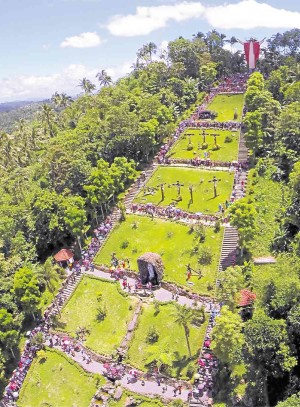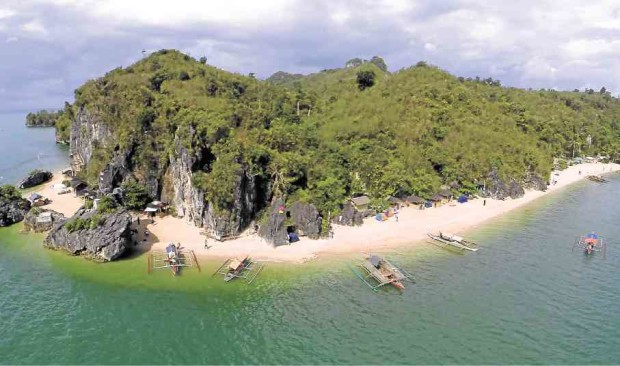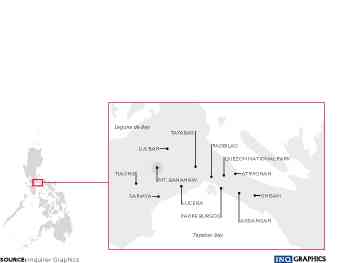48 HOURS IN QUEZON: Food, culture trip

The Kamay ni Hesus Shrine in Lucban town has been drawing pilgrims year round. PHOTOS BY DELFIN P. MALLARI III
LUCENA CITY—With an area of 870,660 hectares, including islands dotting the Pacific Ocean, Quezon province offers visual and gustatory delights to visitors. A two-day stay, mostly in the central towns and cities, is enough to sample the best of its attractions.
Right after a welcome arch along the Maharlika Highway in Barangay Lalig in Tiaong town, a three-hour trip southeast of Metro Manila, is Villa Escudero, a coconut plantation resort. Its Labasin waterfalls restaurant is a perfect spot to enjoy native food “kamayan” style, spread on bamboo tables as gushing waters tickle your bare feet. (Footwear is discouraged.)
A museum of the Escudero clan displays antiques and artifacts. Traditional songs and dances are presented live by resort staff. Enjoy bamboo rafting, a pool swim or a stroll around the farm.
Twenty-three kilometers away is Sariaya, a bucolic town nestled at the foot of Mt. B anahaw and where mansions built during the 1800s to the early 1900s still stand to this day. “These ancestral houses attest to the uniqueness of Sariaya [as it showcases] the work of Filipino and Spanish architects in the old days,” said Eriberto Ricardo J. Dedace, a local heritage researcher.
Dedace guides visitors to a tour of the Don Catalino Rodriguez heritage house, also known as “Villa Sariaya.” For P200, they can have their photographs taken while wearing Maria Clara costumes made of piña fabric or the barong Tagalog of yore.
Article continues after this advertisementThere are beach resorts along the Tayabas Bay, which can be easily reached through a 24-km ecotourism road that cuts through vast coconut fields.
Article continues after this advertisementLucena City, the bustling provincial capital, is 12 km south. Tourists can stay in local inns and hotels for the night. Three—Queen Margarette Downtown, Star Garden and Saint Joseph—are in the downtown area.
After checking in, it’s time for a leisurely stroll. Vladimir Nieto, a local heritage protection advocate, suggests seeing the city’s historical structures—Saint Ferdinand Cathedral, built in 1882 to 1884; the 87-year-old Perez Park, one of the remaining sunken parks in the country; and the 108-year-old, three-story neoclassical “Kapitolyo” building.
The next day, one may take an early morning trip to the bayside town of Padre Burgos in the Bondoc Peninsula. At the pier in Barangay Campo, boats take tourists to Puting Buhangin (which is already in Pagbilao town), Dampalitan and Borawan, which got its name from powdery, white sand beaches similar to Boracay Island, combined with rugged rock formations like those in Palawan province.
After a swim, guests are ferried back to the port. Next stop is Agdangan town, 25 km away, which hosts the 120-foot Luminous Cross of Grace, a chalice-shaped prayer sanctuary. The eight-story structure is built near Saint Isidore Church. (At night, the illuminated cross is a fascinating sight.)

The Lucban Church, known as the Saint Louis of Toulouse Church, is an architectural wonder. —PHOTOS BY DELFIN T. MALLARI JR.
Unisan, 11 km away, is replete with history. Local historians claim that the town is one of the oldest settlements in the country, having been established by Malay settlers in 1521, the same year Portuguese explorer Ferdinand Magellan reached the Philippines.
More than 30 Spanish colonial houses still exist. Made from hardwood and concrete, the ancient houses were built by rich and influential clans and are now owned by descendants.
On the way back to Lucena upon reaching Maharlika Highway in Barangay Malicboy, a detour toward the still-enchanting “Eme” (or M) zigzag road at the Quezon Protected Landscape (formerly Quezon National Park) between Atimonan and Pagbilao towns is an option.
The place is the showcase of herbal plants and products of organizations, cooperatives and individuals involved in the herbal medicines program of the provincial government.
Before dusk, tourists may visit the 145-ha mangrove forest in Barangay Ibabang Pagsalbangon in Pagbilao.
From either Lucena or Pagbilao, one can reach Tayabas City, home to one of the province’s historical treasures—the Malagonlong Bridge, also known as Puente de Malagonlong. The 136-meter stone arch bridge, built between 1840 and 1850, was declared by the National Historical Commission of the Philippines as a “marked historical structure” in August 2011.
Ten other Spanish-era bridges are spread out. The Minor Basilica of St. Michael the Archangel, a favorite place among heritage tourists, was built in 1565 by Franciscan priests and features a 100-meter long aisle.
Last stop, 12 km away, is the town of Lucban, known as the “summer capital” of Quezon. Aside from being known for its pilgrimage destination, Kamay ni Hesus Shrine, the place is popular for its cool breeze and its colorful Pahiyas, a harvest festival in May in honor of St. Isidore, patron saint of farmers and laborers.
The Church of Saint Louis of Toulouse (Lucban Church), built in 1593, is surrounded by Spanish-era stone walls called “quince-quince.”
Clean water from Mt. Banahaw flows through Lucban’s roadside canals.
Local food, craft
Quezon is also known for its local dishes, delicacies and native craft.
A place worth visiting is the workshop, gallery and restaurant of pottery artist, Augusto “Ugu” Bigyan, in Barangay Lusacan in Tiaong. Another itinerary for those looking for exotic and indigenous souvenirs is Martha’s Handicraft by artist and craftsman Cocoy Bernales in Tayabas.
Homegrown shops in Lucban town sell buntal hats and other handicraft items.
Lucena offers fresh seafood that can be bought straight at Dalahican fish port early morning. Its “inipit na isda—“gulyasan” (striped tuna) or “tambakol” (yellowfin tuna) skewered in bamboo sticks and grilled—is a favorite dish during special occasions.
A bowl of “chami,” a noodle dish, is a must-try for visitors .
The flour-based noodle is sautéed with vegetables and meat and topped with chicharon, quail eggs and onions. Chami varieties “balibag sa toyo,” “tamis-anghang” and “chami sa tasa” are served at Peking Restaurant.
Buddy’s, Granja Panciteria, Luto ni Kuya, Antigua Restaurant, Hacienda Inn, and Plaza Food House are among the old favorite outlets.
“Tinapa,” or smoked fish, is the city’s top product. It is sold for P150 to P180 a kilo.

Navigating Atimonan’s zigzag road, known as “Eme” or “bitukang manok” (chicken intestines), is not for the faint of heart.
Jun and Edith’s stall at the public market offers freshly cooked native delicacies, such as “suman” (rice cake or grated cassava wrapped in banana leaves), “minukmok” (pounded cassava or banana and mixed with sugar, margarine and milk), “bibingka,” “budin” and leche flan.
In Lucban, native delicacies are abundant. Try the “longganisang Lucban” (native sausage), pancit Lucban, “hardinera” (a local version of meatloaf), carabeef “kaldereta” and “embotido.”
Workers at Eker and Ely’s at the back of the church prepare the longganisa in full view of patrons. The sausage is also available at Dealo Koffee Klatch and Buddy’s.
Making “mike Lucban” (Lucban noodles) is also for public viewing at Racelis noodle factory. Sprinkled with vinegar laced with chili or soy sauce with calamansi, the noodles are eaten “habhab-style” (slurping from banana leaves). Also known as “pancit habhab,” the noodles are available in eateries or roadside vendors in town.
“Broas” (lady fingers) are sold in Dealo Koffee Klatch and “puto seko” (bite-sized cookies made of cornstarch and sugar) and “meringue” (dessert made from whipped egg whites and sugar) at Ven’s.
Sariaya has “pinagong,” a firm, milky bread shaped like a turtle shell and is best eaten fresh from the oven. Apple Bakery offers the best pinagong.
In Tayabas, assorted native delicacies are sold on the so-called Calle Budin. A popular “pasalubong” is “yema” cake from Monica and Jett Bakeshop, which consists of two layers of sponge cake covered with icing made from condensed milk and egg yolk and liberal sprinklings of grated cheese.
Mallari’s Distillery (not related to this writer) offers “lambanog,” or coconut-based vodka.
The latest attraction is a restaurant inside an airplane, called “Air Summit Gourmet,” located along the Tayabas-Lucban Road in Barangay Dapdap. Also along that stretch is Kamayan sa Palaisdaan, where native food is served.




